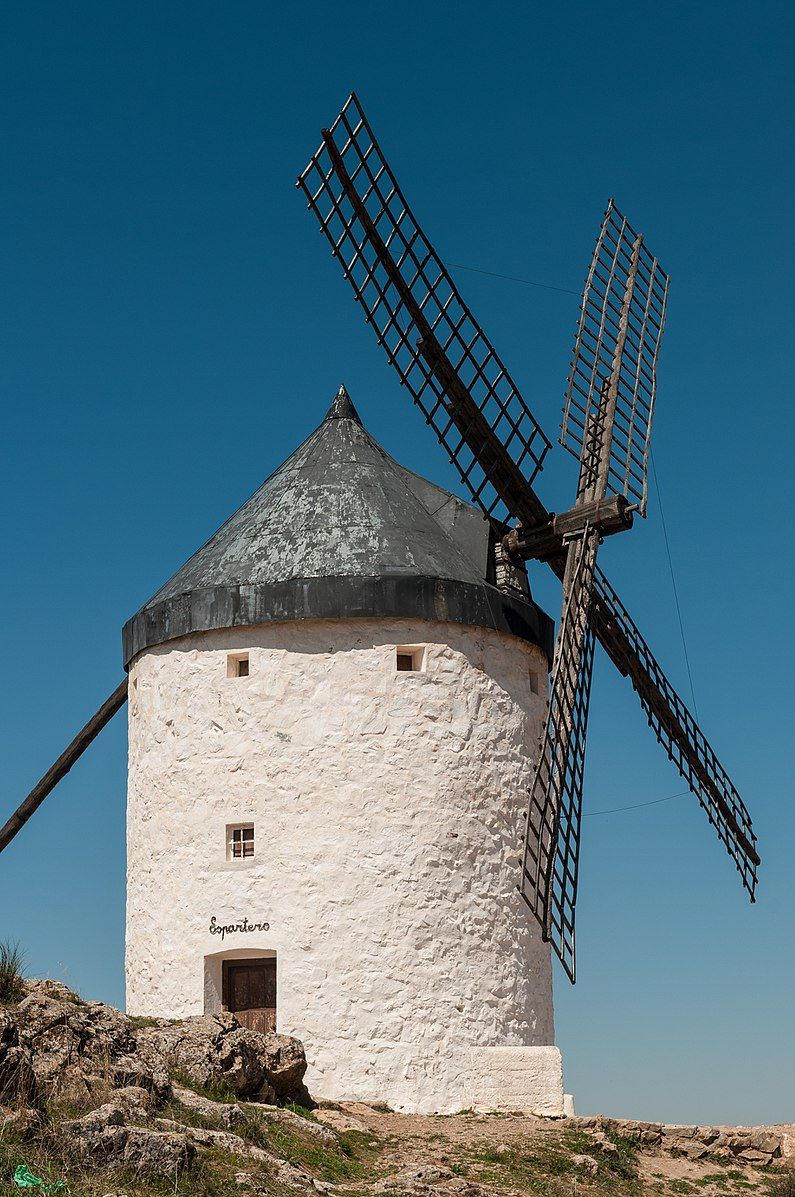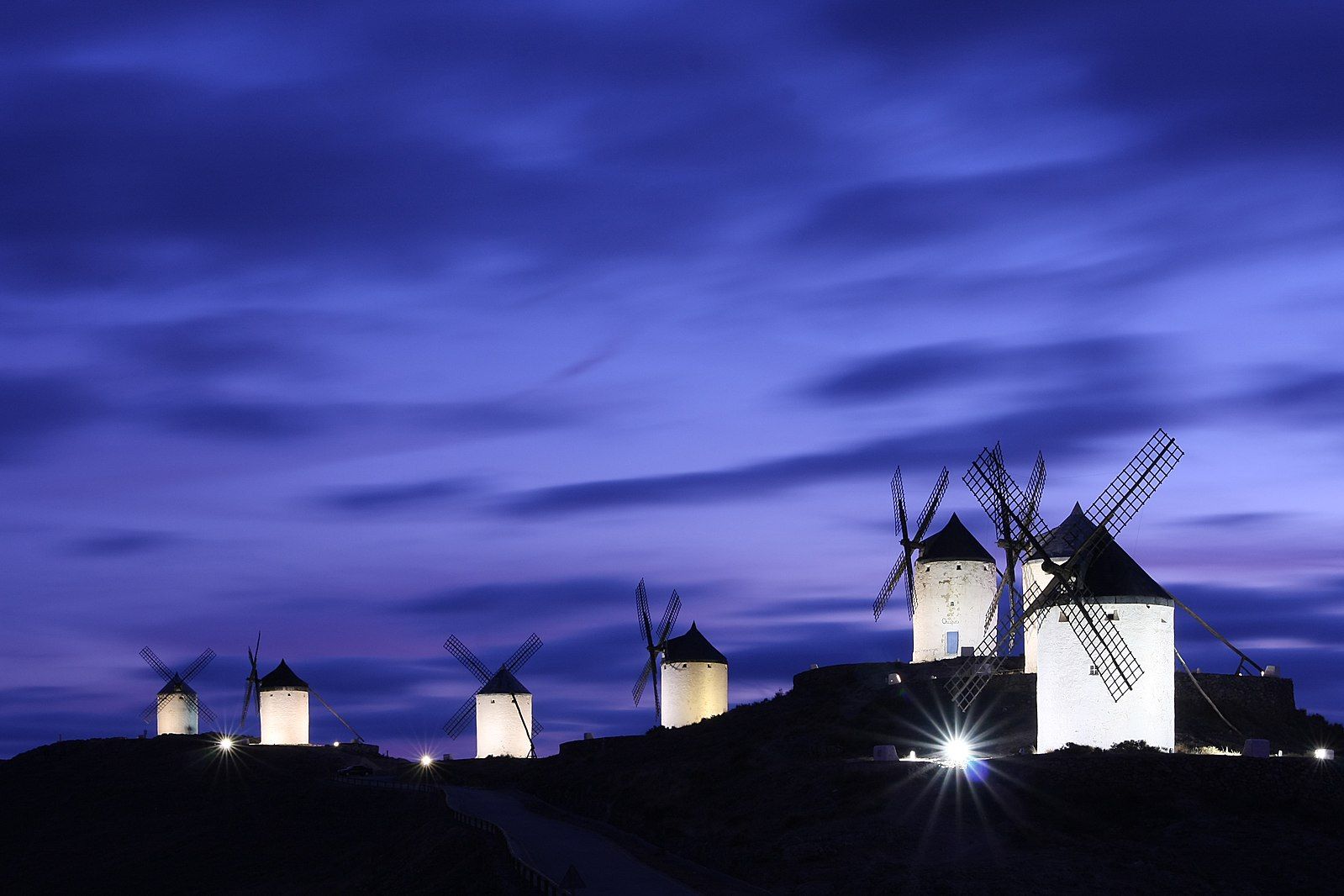Molinos de Viento de la Mancha
Categories/tags: Utilization of water and wind power.
Historical context: Explore the captivating history of the “Molinos de Viento de la Mancha,” the iconic windmills that have become synonymous with the picturesque landscape of La Mancha, Spain. Immortalized in Miguel de Cervantes’ timeless literary work “Don Quixote,” these windmills proudly stand as cultural landmarks, embodying both historical significance and enduring charm.
Form – main architectural features: The distinctive silhouette of the Manchego windmills, with their towering structures and rotating blades, has become synonymous with the picturesque charm of La Mancha. Their origins trace back to tower mills speculated to have emerged from the Mediterranean world in the late XIII or early XIX century. Unlike their hydraulic counterparts, these windmills were strategically positioned in well-ventilated plains or elevated locations, providing an efficient alternative for milling.
From a functional standpoint, the architectural brilliance of the Molinos de Viento de la Mancha lies in their seamless integration into the natural landscape. Their independent placement allowed for optimal wind capture, essential for powering the milling process. Moreover, their design facilitated easy access for maintenance and operation, ensuring their functionality amidst the rugged terrain of La Mancha.
The material used in the construction of the Molinos predominantly includes locally sourced materials that were readily available in the region.Typically, the main structural components were using stone or brick, reflecting the traditional building materials of the area. These materials provided durability and stability, essential for withstanding the test of time and the harsh environmental conditions of La Mancha.
Additionally, wooden elements were commonly utilized in the construction of the windmill’s machinery, including the rotating blades, gears, and internal mechanisms. Wood was chosen for its strength, flexibility, and suitability for mechanical components, allowing for efficient milling operations.
Function: The roots of Molinos de Viento de la Mancha trace back to the XVI century when the first windmills were introduced to the region, initially serving the purpose of grinding grain. These windmills played a crucial role in La Mancha’s agricultural landscape. Evolving with technology, they transformed into enduring symbols of innovation and resourcefulness.
Spain Windmill by ClimAID on Sketchfab
In the contemporary era, Molinos de Viento de la Mancha attract tourists eager to explore Spain’s rich cultural past. Many of these windmills have been meticulously preserved and transformed into museums, offering visitors a chance to delve into their inner workings and gain insight into centuries-old agrarian practices. The region has embraced its cultural heritage, incorporating the windmills into festivals and events that celebrate La Mancha’s rich history.
Despite their enduring charm, Molinos de Viento de la Mancha face challenges in terms of preservation. Weathering, structural deterioration, and the ongoing need for maintenance present continuous challenges. Conservation efforts are actively underway to ensure that these cultural treasures continue to inspire and educate future generations.
In the XIV century, windmills began to dot the La Mancha landscape in response to the increasing demand for milling. Hydraulic mills, limited by season and location, proved insufficient. La Mancha’s windmills gained fame in the XVII century through Cervantes’ work, emerging as the iconic symbol of the region.
Manchego windmills find their origins in tower mills, speculated to originate from the Mediterranean world in the late XIII or early XIV century. Unlike hydraulic mills, their independent location allowed installation in well-ventilated plains or elevations, providing an efficient alternative for milling.
Lessons for sustainability: These windmills played a pivotal role in the regional economy, offering an alternative to hydraulic mills. Their widespread adoption from the XVI century stems from a combination of agricultural boom, demographic growth, and changes in permits for mill construction. Moreover, windmills proved more sustainable, providing quality flour without relying on the seasonal availability of water.
Thanks to Cervantes, Manchego windmills have become an iconic cultural element. Despite the popular perception that La Mancha is the quintessential land of windmills, their distribution was uneven. Towns like Campo de Criptana, Pedro Muñoz, El Toboso, Mota del Cuervo, and others witnessed a significant presence of these windmills.
Cultural heritage and tourism: Despite their late XIX century decline due to economic and technological changes, some have been preserved as part of cultural heritage and tourist attractions, keeping alive the connection with Cervantes’ work.
As they stand against the backdrop of the picturesque landscape, the Molinos de Viento de la Mancha remain not just symbols of the past, but living links to a bygone era.
Location: Toledo – Spain
Molinos de Viento de la Mancha – Spain
Sources
de Cervantes, M. (1605). El ingenioso hidalgo Don Quixote de la Mancha. Biblioteca Virtual Miguel de Cervantes. https://www.cervantesvirtual.com/obra-visor/el-ingenioso-hidalgo-don-quijote-de-la-mancha-6/html/
Ferrer-Roca, N. (2003). Conservation and maintenance of traditional windmills in La Mancha, Spain. International Journal of Heritage Studies, 9(3), 235–252. https://doi.org/10.1080/1352725032000093701
García Sánchez, I., & Vera-Rebollo, J. F. (2014). Windmills and Watermills in La Mancha (Spain): A Brief Historical Overview. Sustainability, 6(10), 6765–6785. https://doi.org/10.3390/su6106765
Hervás Herrera, M. Á., & Sánchez-Bermejo, J. B. (2023). Los molinos de viento de la Mancha. Cultura de Castilla-La Mancha. https://cultura.castillalamancha.es/culturaenredclm/los-molinos-de-viento-de-la-mancha
Hervás Herrera, M. Á., & Sánchez-Bermejo, J. B. (n.d). Campo de Criptana. Molinos de La Mancha, Gigantes del Quijote. Guía oficial del Centro de Interpretación. Campo de Criptana, Ayuntamiento de Campo de Criptana y Diputación Provincial de Ciudad Real. ISBN: 978-84-09-42773-4.
Rojas-Sola, José Ignacio, & Amezcua-Ogáyar, Juan Manuel. (2005). Origen y expansión de los molinos de viento en españa. Interciencia, 30(6), 7-14. Retrieved January 4th, 2024, from http://ve.scielo.org/scielo.php?script=sci_arttext&pid=S0378-18442005000600004&lng=es&tlng=es




